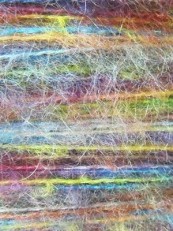Knitting with Mohair
Knitting with Mohair

I’m brain storming, now in the cold weather time as I imagine the warmth of summer, I want handmade garments for summer. I have decided to start with a late spring/summer evening project: Mohair shawl
Everyone has told me that knitting with mohair is difficult and I have likewise discovered this as well; however, I have also found some tricks that makes the process easier.
Knitting with mohair can be difficult, it is difficult to fix mistakes and sometimes it feels as if there is more hair everywhere else then your project!

Things to know about Mohair!
Mohair can be super warm without the weight of wool, or it can help keep you cool wicking the moisture away. The fiber has a lovely drape, doesn’t pill when the fibers are short and is durable. It is excellent for garments; however, mohair unlike wool and similar to alpaca, has little elasticity. 100% mohair is heavy and stretches out, never to return as it once was! For the most part, the largest percentage of mohair fibers is 70% in yarns. Mohair is blended most often with silk and wool. Mohair silk blends will stay the same size as you block them, your can’t re-block, you can rip it all out and steam the fiber then knit again, so know you’re level of knitting.

On most labels of mohair is defined as either “Mohair” or “Kid Mohair.” Traditionally kid mohair is the first shearing off a kid, when it is 6 months old, it is often considered the softest mohair.

Texas grading labels, used in half the US are divided into kid, yearling, adult, by not the age but rather the micron count. So you could have a 4 year old goat that produces “kid mohair” or a yearling that grows “adult.” The younger age label on the yarn is finer, but that’s not a guarantee it will feel soft to you. Not all yarns are equal, some brands, styles or blends are softer than others. The labeling system for American Mohair Marketing uses superfine kid, good kid, superfine yearling, good yearling, superfine adult and good adult. Australian Mohair: Superfine kid, kid, strong kid, young goat, adult. The micron count for kid mohair is often 23-30.
If you’re worried about itchiness, try testing it on the soft skin on the inside of your elbow, hold the fiber there for about 10-15 min if you’re not bothered you should be good to go for not being bothered by that yarn.
Soaking or Washing the Yarn: Removing the residues that can be left from commercially cleaned fibers. Soak the fiber in 10% vinegar water cool for about 10 minutes then rinse, this often removes some of the chemicals used to clean fibers or try specific fiber wash like Unicorn Fiber Wash, SOAK, or Eucalan Woolwash. Just remember when washing don’t agitate if the blend includes wool, then allow the yarn to dry lying flat.

Mohair knitting creates garments that are open and airy but still warm. Less is more, because of the drape and the halo you don’t need to create texture when knitting, but lace work is lovely with mohair, showing the gaps and highlighting the effect of the halo. It is often referred to as a bulky yarn needing large needles. The halo of mohair will often obscure the finer details in most projects, so keep the pattern simple, you’re working with mohair, your goal is to showcase the yarn anyways.
There are two different preferred needle styles for mohair.

Some believe what knitting with blunt tips needles forces you to have more even knitting, the blunt tips makes the knitter attempt to knit in the center as where there should be the least resistance from the halo. However if you’re with a lace pattern, blunt tips can add to difficulties with multi-strand steps.
You can also knit with lace needles to allowing you to pierces though the cloud, and stitch without struggling with the halo. This also allows you to stitch into the halo without catching the structural core of the yarn. Lace needles also help with working multi-strand stitches, but you have to take care knitting regardless of which needles you choose.
When knitting Mohair remember that ripping or frogging is going to be more difficult than knitting. Take time to go slow, it’s frustrating having to pull your work apart but don’t rush. If you have to pull your piece apart keep your hands near the tangles you might find, don’t add extra stress to parts untangles, but rather apply your time and energy to the points that are nearest the tangle or bound spot.
